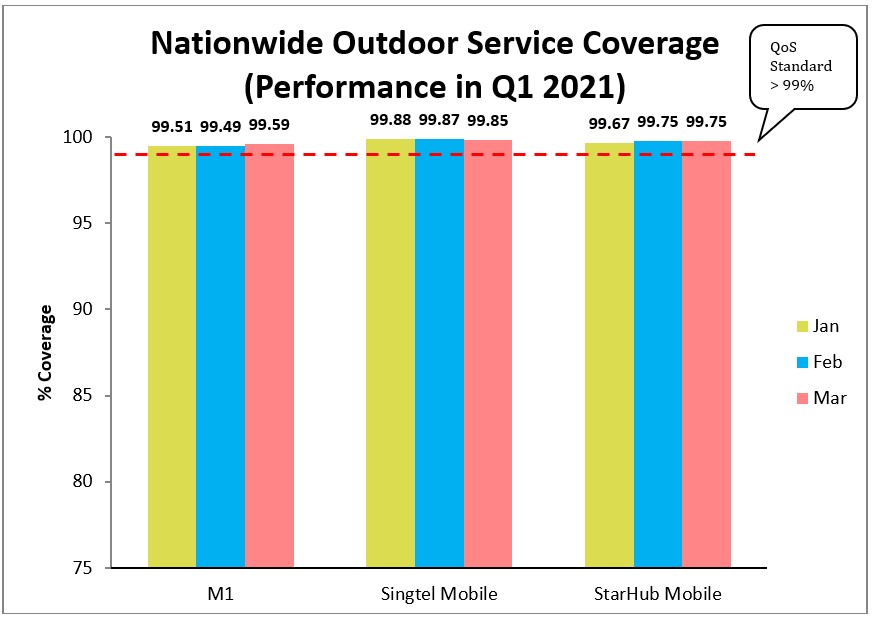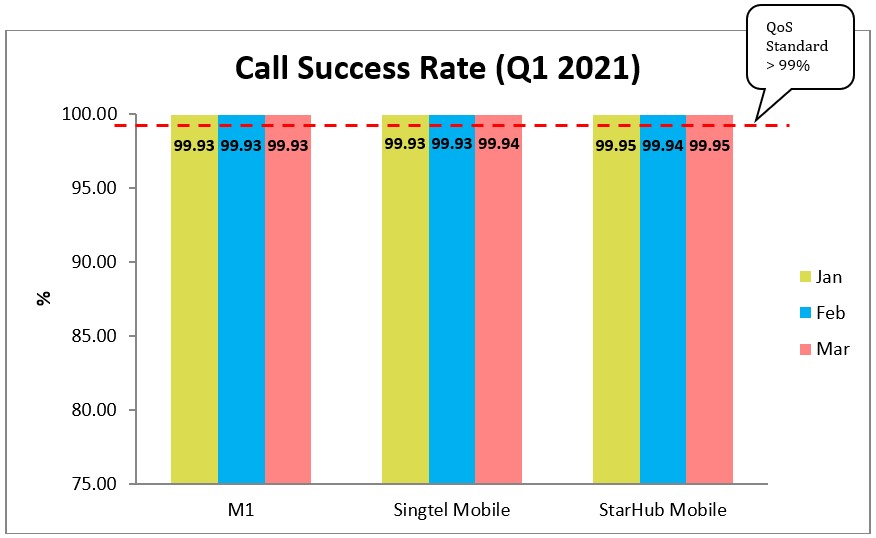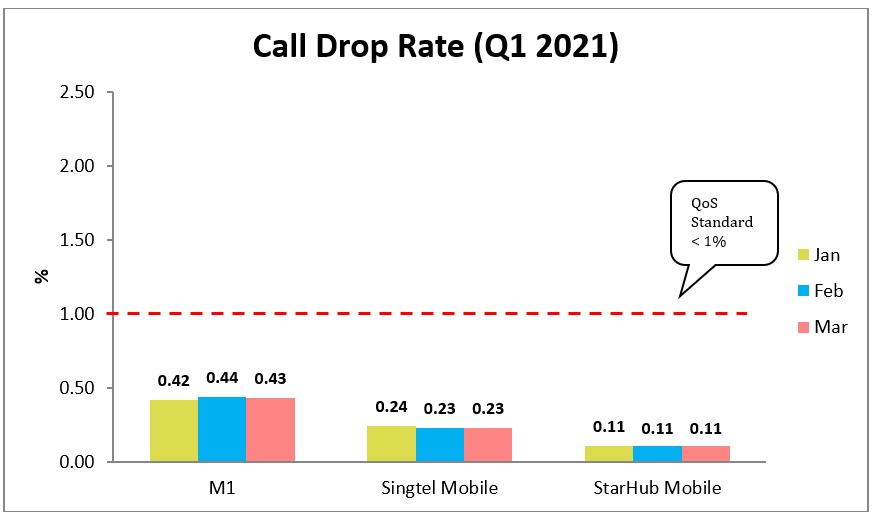Nationwide Outdoor Service Coverage
This indicator measures the Nationwide Outdoor Service Coverage for the 3G cellular mobile networks. Service coverage is determined by signal strength. The availability of service coverage is the ability of a cellular network to achieve the minimum signal strength of at least -103dBm. Under IMDA's 3G Public Cellular Mobile Telephone Service ("PCMTS") QoS framework, mobile operators are required to achieve Nationwide Outdoor Service Coverage of > 99%. In order to better measure the end users' experience*, IMDA uses mobile phones to collect the signal strength data points.

*Based on IMDA's coverage performance surveys which included nationwide outdoor drive test and areas such as housing estates/town centres, outdoor recreational areas and above ground MRT tracks.
Note: End users' individual experience may differ due to different models of handset used, handset settings, number of users in the vicinity, etc.
Call Success Rate
This indicator measures the percentage of successful call attempts made on the 3G cellular network. A call attempt is deemed successful when the calling party (the individual who makes the call) gets connected to the called party (the individual who receives the call) or receives a busy tone. Under IMDA's 3G PCMTS QoS framework, the mobile operators are required to achieve > 99% success rate (average across all cell localities during busy hour).

Note: Call success rates are based on the mobile telecommunication operator's actual network traffic logs.
Call Drop Rate
This indicator measures the percentage of unintended disconnection of 3G mobile calls by the cellular network during a 100 second call. Under IMDA's 3G PCMTS QoS framework, mobile operators are required to achieve < 1% drop call rate (average across the entire month).

Note: Call drop rates are based on the mobile telecommunication operator's actual network traffic logs.
In-building Service Coverage
This indicator measures in-building service coverage for the 3G cellular network. Under IMDA's 3G PCMTS QoS framework, mobile operators are required to achieve a service coverage of > 85% per building. Service coverage is measured at randomly selected buildings and at publicly accessible areas within the tested buildings as a proxy for the coverage in the entire building to avoid disturbing residents. For buildings that have failed IMDA's compliance standard, mobile operators will have a period of four months to improve the coverage within the buildings. IMDA will audit the buildings again after the four-month period.
IMDA's Performance Survey Period: Q1 2021
| M1 | Singtel Mobile | Starhub Mobile |
|---|---|---|
| No of buildings passed/No of buildings tested Compliance standard > 85% per building |
||
| NA | 60/60 | NA |
Note: The same sixty buildings were tested across the mobile operators. The performance of each of the mobile operator varies for each of the building tested. End users' individual experience may differ due to different models of handset used, handset settings, number of users in the vicinity, etc.
As the large majority of end users have migrated to or are capable of receiving 4G services, IMDA has waived the 3G in-building QoS standard for mobile operators whose 3G subscriber base has declined to below 10% of their total subscriber base, and who have committed to actively assist their 3G subscribers to migrate to 4G services or 4G handsets.
Tunnel Service Coverage
This indicator measures the service coverage for the 3G cellular mobile network within road and MRT tunnels. Tunnel service coverage measures the percentage of data points collected in a tunnel from a 3G cellular mobile network that achieve a minimum signal strength of at least -103dBm. The tunnel areas surveyed by IMDA include all road and MRT tunnels in Singapore. In order to better reflect end users' experience, IMDA uses mobile phones to collect the signal strength data points. Under IMDA's 3G PCMTS QoS framework, mobile operators are required to achieve a service coverage of > 95% and > 99% for existing and new road and MRT tunnels respectively.
IMDA's Performance Survey Period: Q1 2021
|
M1 |
Singtel Mobile |
StarHub Mobile |
|---|---|---|
|
Compliance standard: > 95% for existing road and MRT tunnels; and > 99% for all new road and MRT tunnels* |
||
|
Central Expressway (Road Tunnel)* |
||
|
Pass |
Pass |
Pass |
|
Kallang-Paya Lebar Expressway (Road Tunnel) |
||
|
Pass |
Pass |
Pass |
|
Fort Canning Tunnel (Road Tunnel) |
||
|
Pass |
Pass |
Pass |
|
Woodsville Tunnel (Road Tunnel) |
||
|
Pass |
Pass |
Pass |
|
Marina Costal Expressway (Road Tunnel) |
||
|
Pass |
Pass |
Pass |
|
Sentosa Gateway Tunnel (Road Tunnel)* |
||
|
Pass |
Pass |
Pass |
|
North South Line (MRT Tunnel) |
||
|
Pass |
Pass |
Pass |
|
East West Line (MRT Tunnel) |
||
|
Pass |
Pass |
Pass |
|
Circle Line (MRT Tunnel) |
||
|
Pass |
Pass |
Pass |
|
North East Line (MRT Tunnel) |
||
|
Pass |
Pass |
Pass |
|
Downtown Line (MRT Tunnel) |
||
|
Pass |
Pass |
Pass |
|
Thomson-East Coast Line (MRT Tunnel) |
||
|
Pass |
Pass |
Pass |
* Where deployment work for telecommunication infrastructure within the road and MRT tunnels was committed by mobile operators after January 2012, IMDA will consider these tunnels to be new tunnels for the purpose of QoS measurements. Therefore, even though the Central Expressway is not a new road tunnel, the mobile operators have carried out upgrading works in the CTE after January 2012, and the higher standard of > 99% applies. The standard of > 99% also applies to the Sentosa Gateway Tunnel and the Thomson-East Coast Line Tunnel. The rest of the tunnels listed above will continue to be subject to the standard of > 95%.
Note 1: End users' individual experience may differ due to different models of handset used, handset settings, number of users in the vicinity, etc. The tunnel service coverage results are based on IMDA’s coverage performance surveys.
Explanatory Note: IMDA has adopted -103dBm for 3G QoS measurement from 1 April 2020 to adjust to newer test handsets, where performance is optimised for 4G networks instead of 3G networks.


.webp)